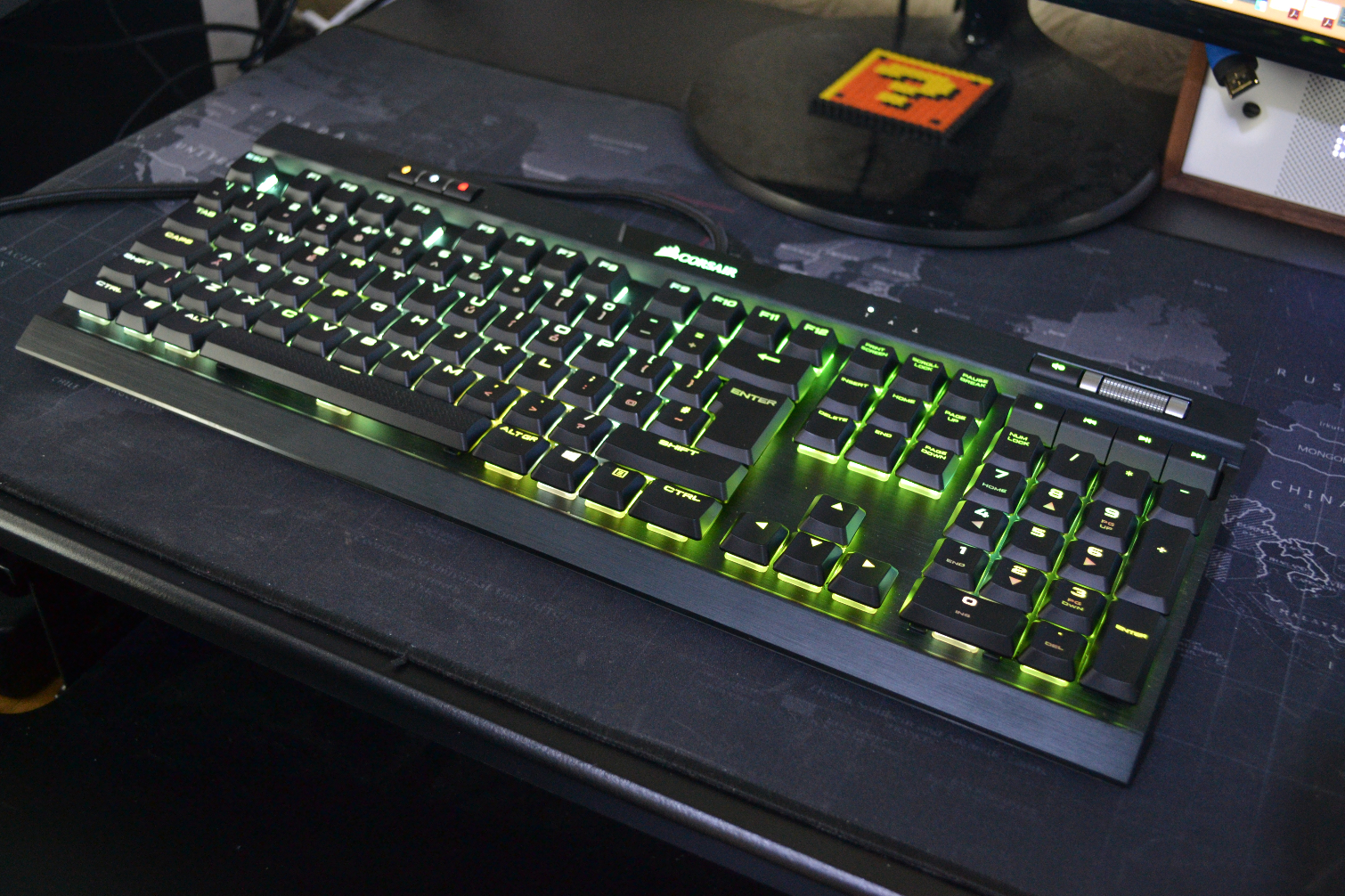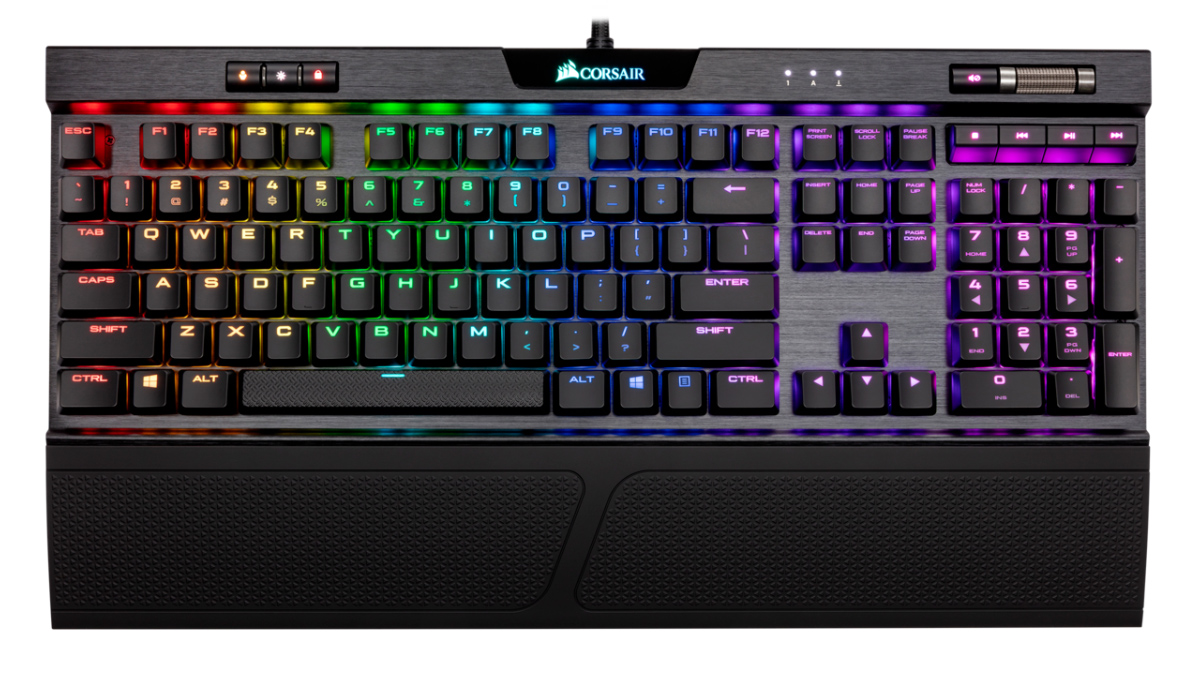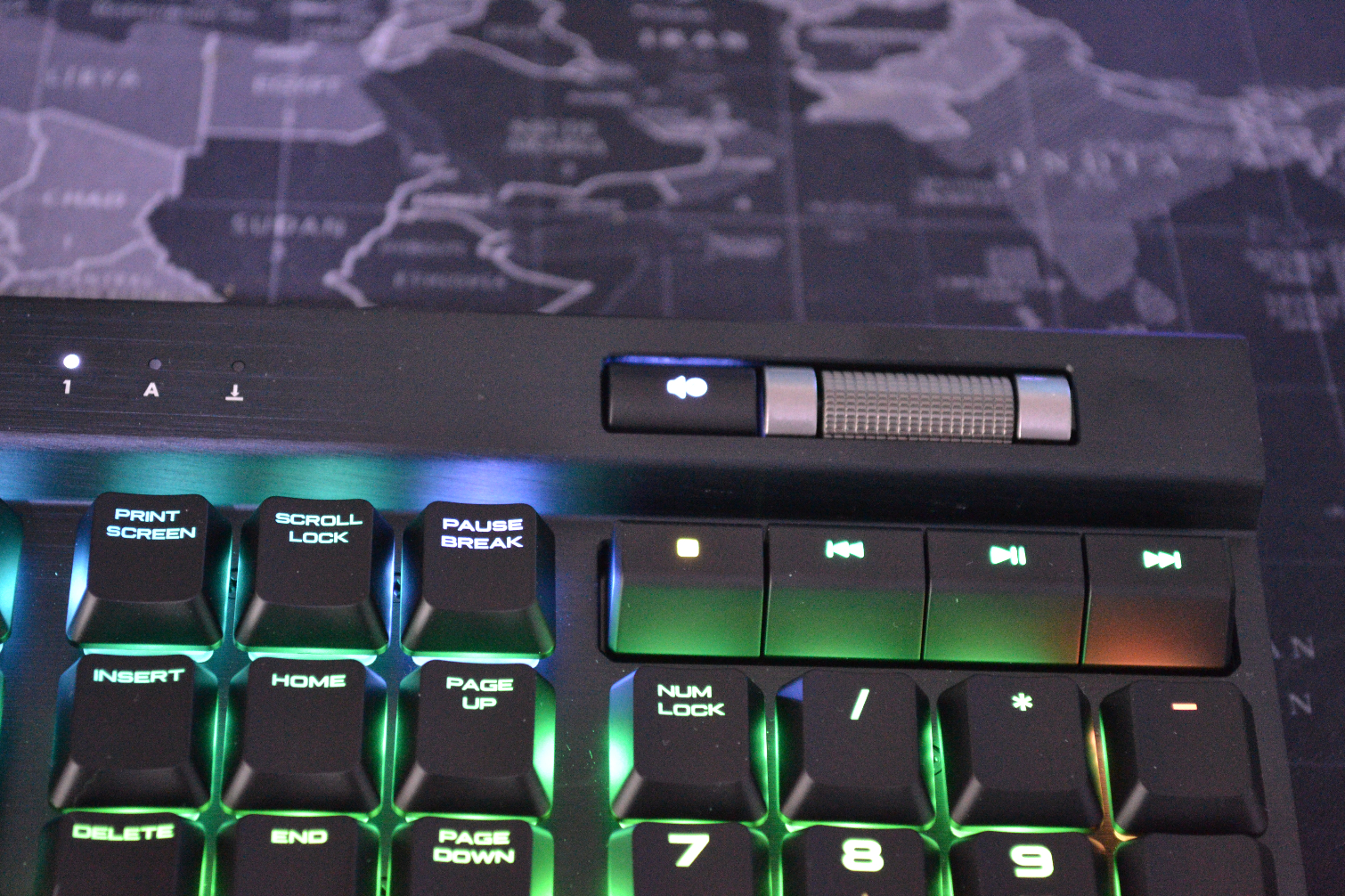Tom's Hardware Verdict
Unless you were absolutely tied to the idea of low-profile keys, we'd probably opt for the big boy K70 over this. It's a fine keyboard with some smart features, but there's a lot not to like – and much of that is the fault of its switches.
Pros
- +
Slim design
- +
Highly responsive
- +
Attractive lighting
- +
Passthrough and volume roller
Cons
- -
Terrible wrist rest
- -
Questionable key feel
- -
Clunky cable
- -
Expensive
Why you can trust Tom's Hardware
Cherry's introduction of low-profile switches seems to have given every keyboard manufacturer ideas. Corsair's latest take on the tech, which refactors its full-height K70 into a pair of flattened-down versions of the same style, wouldn't exist without that tantalizing new slimmer switch option. But if nothing else, the low-profile switches do a good job of justifying the K70 RGB MK.2's place on the planet. It's a portable, pared-down keyboard that doesn't pull any punches when it comes to shiny extras. We're looking at the Cherry MX Red low-profile version here, and Corsair has also put out a RapidFire edition which applies Cherry's super-light MX Speed switches to the same physical layout.
The red-switched variety was the only one with any wide availability when we wrote this, and selling for a teeth-clenchingly expensive $170/£160, though US purchasers may find it discounted to around $130 on sites like Amazon. It's worth noting that opting for the low profile version of the K70 MK.2 adds a price premium of around $10/£10 on top of the standard version, so you'd better really want low-profile switches.
Design and Comfort
When Corsair says 'Low Profile', it really means it. The barely-tapered base is thin enough that there's hardly any room between the lower limit of the key switches and your desk, leaving the keycaps at around the same height you'd find the top panel of some keyboards. Thankfully, the company has resisted going the flat-key route that Cooler Master took with its similarly slim SK650 and SK630 models. While it's reduced in height, Corsair has presented this in essentially the same way as the standard-height K70 MK. 2. It has a chin, onto which the disappointingly plasticky and slippery wrist wrest clips, and a rear shelf which houses a volume roller, some customization buttons, and a single pass-through port.
That wrist rest, then. It's nice that Corsair included one, and the way it clips on is satisfying and sturdy. But it doesn't feel in any way pleasant. It's textured with tiny triangular bumps, which somehow don't add any grip to proceedings. If you would like to experience the skin-crawling effect that comes from involuntarily rubbing one's lower palms / upper wrists on a horrible surface, then by all means do. But we'd advise you leave it in the box where it belongs. The low profile and flat angle of the K70 MK.2 lends itself better to raw desk-resting anyway.
Other design missteps include the unnecessarily widened cyber-font used on the keys, which does little but take down the class a notch, and the rather small feet which make next to no difference to the keyboard's angle, but do make it slide around a little more than when the full footprint of the silicon pads underneath are in contact with your desk. For a keyboard that's supposedly well-suited to slinging in a bag, it has a thick and somewhat unyielding braided cable, too. After the Cooler Master MK850's detachable USB 3 cable, perhaps we're just a little spoiled.
Credit, though, to the media keys, which have somehow resisted the call of being barely-prominent nubs and instead stand as proud and angular buttons above the number pad. They're good.
Specifications
| Switch | Cherry MX Red Low Profile |
| Lighting | Per-key RGB |
| Onboard Storage | 8MB |
| Media Keys | Yes |
| Game Mode | Yes |
| Microcontroller | Unknown |
| Key Rollover | NKRO 100% anti-ghosting |
| Polling Rate | 1000Hz / 1ms |
| Interface | USB 2.0 |
| Cable | 1.8m/ 6ft |
| Additional Ports | 1x USB 2.0 passthrough |
| Keycaps | ABS |
| Construction | Plastic / Anodized Aluminum |
| Accessories | Wrist rest, alternate gaming keycaps |
| Software | Corsair iCue |
| Dimensions (WxDxH) | 18.7 x 6.1 x 1.7 inches / 475 x 154 x 43mm |
| Weight | 1.08kg / 38oz |
| Warranty | 2 years |
Typing Experience
Whenever we talk key switches, there's a hint of worry to our assessment: What if you, the reader, like switches that we don't? What if you're actively looking for something soft and squashy and oddly rough feeling? If you are then you'll love how Cherry's MX Red low-profile switches have been employed here. They swap out the satisfying and sharp linear action of the full-size edition for something else entirely. We guess they've been given the same color designation because of their weighting and silent travel, and in that respect they're very similar. But don't come into this expecting the same typing experience as the full-height variety offers.
Get Tom's Hardware's best news and in-depth reviews, straight to your inbox.
Here's the thing though: Whether we're blown away by the switches or not –- and we're not –- they make for a very good typing experience. They actuate high, particularly considering they're low-profile switches, but there's enough resistance to prevent mistyping. The visually cramped keycaps are actually pretty well suited to typing, with a harsh angle to their dished tops making for a very definite key feel. And that lack of crispiness, combined with short travel, leads to a highly comfortable and un-strenuous typing experience, which is something not every mechanical keyboard can match.
Let's also give special mention to the space bar. It's on the quieter end, with very little rattle from its bracing, and Corsair has seen fit to give it a texture to match the wrist rest and the alternate gaming keys you'll find in the box. This (while initially a little distracting) adds to the accuracy of the touch typing experience. It's a small tweak, but we appreciate it.
Gaming Experience
Short-throw switches are often polarizing for gamers, and we can understand why. Having the right tool under your fingers is vital, and the definite movement of a full-height mechanical switch is reassuring in a way that this can't match. That said, we actually quite enjoyed employing it for gaming; while there's sensitive actuation, the low-profile Reds are stiff enough to resist resting fingers. And while a shorter throw clearly isn't for everyone, the contrast isn't quite as marked as you might expect it to be. There's only 0.8mm difference in travel between these switches and their full-height cousins. They might be squat, but the Cherry MX Red low-profile switches here are a long way from scissor switches or low-profile membrane designs we’ve seen in the past.
Subjectively, we weren't entirely satisfied with the feel of the K70 MK.2 in high-movement games like, er, Doom II (we have our obsessions, don't laugh). It does come back to that key switch engineering, rather than its height –- squashy inputs, however accurate and quick they may be, can't quite pass that message back up your fingers to your brain--or at least to mine. The keyboard is well-factored towards gaming, though: There's full anti-ghosting and 1ms polling to ensure your inputs are read properly, however clumsily you might make them.
Lighting and Software
Per-key lighting naturally means the K70 MK.2 has a host of attractive RGB effects on offer, and while Corsair's lighting here is maybe a couple of lumens dimmer than we've seen on some keyboards, it's still rather impressive. The dark finish to the aluminum top case gives good isolation to the keys, while its mild reflectivity, and the clear base of the switches, adds a cute glow. This is particularly apparent on the rear shelf and low lip along the front of the K70, which catch the light brilliantly and, we suspect, have as much an aesthetic purpose as they do a practical one. There's not a lot of on-board customization; you can flick between three modes or kill the lights entirely if the rainbow swirling gets too much, but that's about it.
Thankfully Corsair's iCue software is fully-featured, giving you access to everything from, yes, lighting effects (synced to other Corsair kit, if you have it) and more granular controls, like customizing the behavior of the Windows Lock key, macro recording which can include mouse control, and even adjusting the polling rate. It's neat enough, and not too system-intrusive. But you don't absolutely need to use it.
Bottom Line
The K70 RGB Mk.2's Low Profile's poise, looks and effectiveness did a great job of winning us over given its less-than-stellar key feel and sometimes questionable design. It's a real mixed bag, and one which will appeal to some users more than others. If you do happen to be in the market for something slim, it's arguably a better choice than Cooler Master's SK630/650, although that clacker has aesthetic advantages of its own.
Image Credits: Tom's Hardware
MORE: Best Gaming Keyboards
MORE: All Keyboard Content
-
wraithr32 LOL, everyone has their own opinions. I have the Mk1 with Silver speed and the mk2 with low profile silver speed and I prefer the low profile for typing, don't mind the wrist rest but prefer the media keys on the Mk1 and not the big bulky ones on the mk2.Reply
The typing sound is quite different between the 2 as well, the low profile are a lot quieter. -
howiejcee Yeah, 3 of the cons are personal preference/opinions:Reply
"Terrible wrist wrest" - I actually like it. It has enough texture and the material has a slightly rubbery feel making it feel not too hard and not too "sticky" especially when sweaty. One thing I did notice though is that the corners were pretty sharp so I filed/rounded them a little (only took a few seconds to do).
"Questionable key feel" - This keyboard replaces my old K70 Lux RGB Cherry MX Silent, and I can type faster and more accurately on this RapidFire one. It feels more responsive too due to the Cherry MX Speed keys but these are certainly noticeably louder than the MX Silent ones.
"Clunky Cable" - I've owned several higher end gaming keyboards and while this cable feels somewhat more rigid due to its outer braided layer, it also seems much more durable and less prone to damage from pinching or abrasion. Higher flexibility would be an improvement but that could take away from its durability which is more important imo. You don't want the hassle of repairing or replacing a keyboard due to a cable failure...I do agree that these keyboards are somewhat pricey though. -
Ninjawithagun Excellent - now all they have to do is to offer the K65 in the same low profile form factor ;)Reply -
jimmysmitty Replyhowiejcee said:Yeah, 3 of the cons are personal preference/opinions:
"Terrible wrist wrest" - I actually like it. It has enough texture and the material has a slightly rubbery feel making it feel not too hard and not too "sticky" especially when sweaty. One thing I did notice though is that the corners were pretty sharp so I filed/rounded them a little (only took a few seconds to do).
"Questionable key feel" - This keyboard replaces my old K70 Lux RGB Cherry MX Silent, and I can type faster and more accurately on this RapidFire one. It feels more responsive too due to the Cherry MX Speed keys but these are certainly noticeably louder than the MX Silent ones.
"Clunky Cable" - I've owned several higher end gaming keyboards and while this cable feels somewhat more rigid due to its outer braided layer, it also seems much more durable and less prone to damage from pinching or abrasion. Higher flexibility would be an improvement but that could take away from its durability which is more important imo. You don't want the hassle of repairing or replacing a keyboard due to a cable failure...I do agree that these keyboards are somewhat pricey though.
Corsair keyboards have always been a bit pricey. But to be fair they have also always been good build and strong quality pieces. My K90 is nbow 7 years old and short of the numlock LED going out, the keyboard is in pretty damn good shape. The cable looks brand new as well. I have been using it as a work keyboard because screw the wireless dome key crap they give us, plus I have a K95 RGB at home so it was just collecting dust.
I agree most of the cons themselevs are personal preference. I know people who only buy Cherry MX browns and others who only buy blues. Some like the clicky feeling others don't. Hell I know some people who love dome based keyboards. I mean they are special people but still what they prefer is what they prefer.



